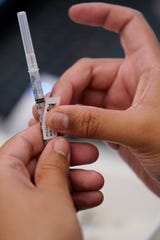To defeat COVID-19, remember the children and don’t let down your guard
Americans face a challenge of our own making on the path to herd immunity: our failure to properly consider the needs of children.
While we can celebrate the fact that nearly 200 million doses of COVID-19 vaccines have been administered in the U.S., few of them, outside of clinical trials, have gone into the arms of children younger than 16. That’s why we need to recalibrate our expectations — and redouble our efforts — so that the tens of millions of children in this country are kept safe.
As both parents and pediatricians, we’re troubled by the governors who appear to have declared victory, removing mask mandates, fully reopening businesses, and acting with apparent disregard for what this virus is capable of. What was true a year ago remains so today: children are only protected when adults do their part. When adults get vaccinated, a growing body of evidence suggests that they also protect those who cannot: children and people with medical conditions which preclude them from being vaccinated. But until children are vaccinated, they and many adults in their communities will be at risk, and a full return to normal life is premature.
COVID effects on children
The silver lining of this pandemic — that children have largely been spared the worst health effects — has fed our complacency. Children have represented a smaller percentage of cases overall, and among children who have gotten COVID-19, most have had either mild symptoms or none at all. Even so, hundreds of children have died, and many have endured long-term effects. The National Institutes of Health is in the nascent stages of gathering enough data to better understand COVID-19’s impact on children. What we do know is that the virus remains a threat, especially in those children with underlying health conditions and other disabilities.
COVID vaccine on April 15, 2021, in Miami, Florida. (Photo: Wilfredo Lee/AP)
Recent trends should make parents, other caregivers — and especially policymakers — think twice about letting down our guard: more than 73,000 kids were diagnosed with COVID-19 in the first week of April, the highest weekly total in nearly two months. Similar to what we’ve seen with adults, children of color have fared the worst, with Black and Latino children representing nearly 70% of children who have been diagnosed with a related, severe pediatric inflammatory illness known as MIS-C. Tragically, more than 40,000 children have lost a parent to COVID-19, with a disproportionate share of the losses being borne by Black children, according to a recent study in JAMA Pediatrics. In addition to the direct toll COVID-19 has taken on children, the indirect toll from parental loss, social isolation, and economic hardship has had significant psychological impacts.
Children also have suffered because of our nation’s failure to adequately prioritize their non-medical needs. One stark example has been our approach to schools. Even as we learned that schools could reopen safely when given enough resources to put protective measures in place, we acted too slowly. In many states, restaurants are opening for indoor dining before children are being welcomed back to the classroom, despite data showing that indoor learning is safer than indoor dining. The resulting uneven educational experiences and mental health toll from ongoing school closures has been significant, with Black and brown children once again paying the heaviest price because of the inequitable way schools in America are funded. We are heartened that more schools have reopened, and the American Rescue Plan Act includes $120 billion in additional federal funding for K-12 schools. But the ramifications of not prioritizing and funding schools sooner, and not directing more resources to schools that have been chronically underfunded, might be felt for years or even generations to come.
Spreading vaccines worldwide: To get more vaccines worldwide, US companies need to give up their intellectual property rights
We now know enough to take steps to mitigate the pandemic’s effects on children, beginning with three fundamental steps:
Start preparing now for the approval of COVID-19 vaccines for children. The FDA will review the data around the vaccines currently in trials in children and decide whether to authorize their use. If the vaccines are found to be safe and effective, children ages 12-15 might be eligible for vaccinations by this summer, with younger children to follow early in 2022. States must plan for this possibility now. We each have vaccinated thousands of children in our respective pediatric practices and know firsthand the value of ensuring that healthcare providers who care for children are the primary point of contact for childhood vaccinations. It is where children are the most at ease and where parents have the most trust — the most critical success factor with vaccinations. We encourage states to ensure that the maximum number of children can be vaccinated where they are used to being vaccinated while also ensuring access for those who may not have insurance or a regular healthcare provider.
Maintaining policies to keep children safe
Maintain public health measures for as long as necessary. As more people are vaccinated each day, we continue to move closer to some semblance of a normal life, but we’re still months away from children joining the ranks of the vaccinated. Until our public health leaders say otherwise, wearing masks, social distancing, washing hands, limiting travel, and avoiding crowds must remain the norm. We have seen the consequences of politics intruding upon public health and states lifting these types of measures too quickly. We will not need them forever, but we still need them today.
Ensure the policy response to COVID-19 reflects children’s broad range of needs. In 2019, federal expenditures on policies and programs for children represented less than 10% of total federal budget outlays. Provisions of the recently enacted American Rescue Plan Act are a good start on a needed push to invest more in our children and their families. Provisions of that law — including a temporary extension of federal unemployment benefits and nutrition assistance benefits; direct cash payments; and expansion of the child tax credit — are projected to reduce child poverty by half in 2021. But we cannot return to an inequitable status quo after the pandemic when it comes to children. Achieving universal health coverage, permanently increasing nutrition benefits and child tax credits, ensuring safe and secure housing, expanding access to paid leave and child care, and instituting a more equitable approach to school funding must be on the front burner of our nation’s policy agenda.
America’s teacher shortage: How to attract more, better educators into classrooms
We have reached a critical juncture in the pandemic, with climbing vaccination rates, declining death rates and effective short-term policy responses. Even so, this pandemic is not over: tens of thousands of new cases are still reported each day, variants are spreading rapidly and some states’ commitment to public health guidance is waning. The policy and public health decisions we make over the next few months will determine when and how this pandemic will end.
Our children have been steadfast in their patience, given what they’ve endured. Now it’s our turn to remain steadfast in our efforts to keep them safe.
Richard Besser, president and CEO of the Robert Wood Johnson Foundation, worked at the Centers for Disease Control and Prevention for more than a decade, including as acting director at the dawn of the H1N1 pandemic in 2009. Follow him on Twitter: @DrRichBesser. Julie Morita, executive vice president of RWJF, was a commissioner for the Chicago Department of Public Health and served on the Biden Transition COVID-19 Advisory Board in a personal capacity. Follow her on Twitter: @DrJulieMorita
You can read diverse opinions from our Board of Contributors and other writers on the Opinion front page, on Twitter @usatodayopinion and in our daily Opinion newsletter. To respond to a column, submit a comment to [email protected].
Source: Read Full Article



